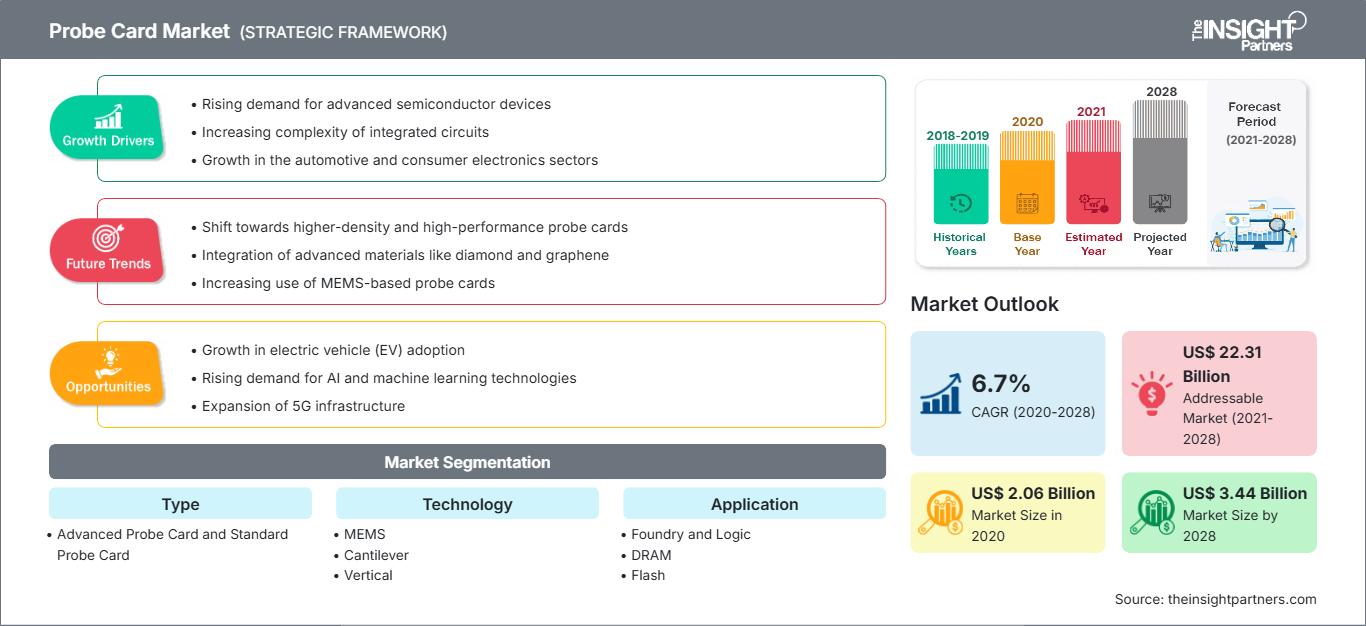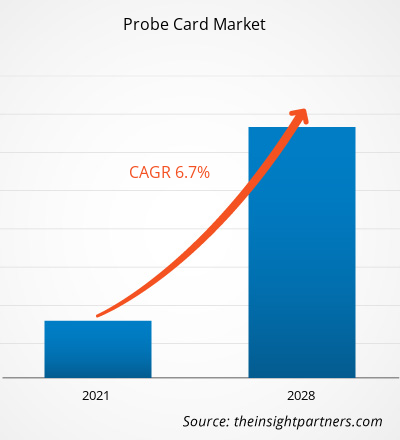프로브 카드 시장 규모는 2020년 20억 5,980만 달러에서 2028년에는 34억 3,680만 달러로 성장할 것으로 예상되며, 2021년부터 2028년까지 연평균 6.7%의 견실한 시장 성장을 보일 것으로 예상됩니다.
프로브 카드는 반도체 웨이퍼를 테스트할 수 있도록 하는 인터페이스입니다. 반도체 제조 초기 단계에서 이 절차는 집적 회로 또는 잠재 의미 색인의 품질을 평가하는 데 사용됩니다. 대부분의 경우 프로브 카드는 프로버에 기계적으로 도킹되고 테스터에 전기적으로 연결됩니다. 프로브 카드의 주요 목적은 테스트 장비와 웨이퍼 회로를 전기적으로 연결하여 회로를 테스트할 수 있도록 하는 것입니다. 인쇄 회로 기판(PCB)과 다양한 유형의 접촉 소자는 프로브 카드의 기본 구성 요소입니다. 프로브 카드는 다양한 요소를 고려하는데, 그중 일부는 매우 일반적인 요소이고 다른 일부는 매우 특수한 용도로 사용됩니다. 가전제품 산업은 휴대폰, 데스크톱, 디지털 카메라, 태블릿, 노트북, 하드 드라이브, TV 등의 사용 증가와 새로운 기술의 끊임없는 연구 및 도입으로 발전해 왔습니다. 스마트 기기와 사물 인터넷의 도입, 태블릿의 보급 확대, 그리고 대형 화면 기기에 대한 수요 급증은 프로브 시장 성장에 기여하고 있습니다. 반도체 수요는 칩 크기 트렌드의 변화와 다양한 전자 제품에서 창의적인 아키텍처에 대한 선호도 증가로 인해 촉진되었습니다. IC 칩 제조 규모의 증가는 전자 테스트 수요 급증으로 이어졌고, 이는 프로브 카드의 수요를 증가시키고 있습니다. AI와 IoT와 같은 최신 기술이 반도체 생산 장비에 통합됨에 따라 제조 시설에서의 도입이 가속화될 것입니다. 또한, IoT 기기용 실리콘 기반 센서 수요 증가, 신흥국에서의 칩 산업 입지 확대, 그리고 데이터 센터 및 서버 수의 증가는 반도체 산업의 실적 향상에 기여하는 요인이며, 이는 프로브 카드 수요 증가로 이어집니다.
바이러스 전파를 최소화하기 위한 전 세계적인 봉쇄 조치는 여러 제조업체, 특히 중소기업의 생산량과 함께 공급망 활동에 상당한 차질을 초래했습니다. 반도체 산업은 산업 부문과 최종 사용자의 전자 부품 수요가 감소하면서 큰 타격을 입었습니다. 봉쇄 기간 동안 대량 생산이 이루어지지 않아 마이크로일렉트로닉스의 수익 모델이 하락했습니다. 봉쇄 이후, 생산 시설들이 사회적 거리두기 조치를 시행하며 운영을 재개하면서 반도체 산업은 시장 점유율을 회복하기 시작했습니다. 또한, 재택근무 및 원격 모니터링 전략은 연결성 향상을 위한 첨단 전자 제품 판매 증가에 기여했습니다. IT 및 통신 산업에서 통신의 중요성이 부각되면서 IoT 연결 및 고속 Wi-Fi 호환 패키징 기술과 같은 새로운 기술로 산업이 발전할 수 있었습니다.
요구 사항에 맞게 이 보고서를 사용자 정의하십시오.
이 보고서의 일부, 국가 수준 분석, Excel 데이터 팩을 포함하여 모든 보고서에 대한 사용자 정의를 무료로 받을 수 있을 뿐만 아니라 스타트업 및 대학을 위한 훌륭한 제안 및 할인을 이용할 수 있습니다
프로브 카드 시장: 전략적 통찰력

- 이 보고서의 주요 주요 시장 동향을 확인하세요.이 무료 샘플에는 시장 동향부터 추정 및 예측에 이르기까지 데이터 분석이 포함됩니다.
이 보고서의 일부, 국가 수준 분석, Excel 데이터 팩을 포함하여 모든 보고서에 대한 사용자 정의를 무료로 받을 수 있을 뿐만 아니라 스타트업 및 대학을 위한 훌륭한 제안 및 할인을 이용할 수 있습니다
프로브 카드 시장: 전략적 통찰력

- 이 보고서의 주요 주요 시장 동향을 확인하세요.이 무료 샘플에는 시장 동향부터 추정 및 예측에 이르기까지 데이터 분석이 포함됩니다.
프로브 카드 시장 보고서에 따르면 아시아 태평양 지역이 글로벌 프로브 카드 시장 점유율에서 대부분을 차지할 것으로 예상됩니다. 아시아 태평양 지역은 중국, 인도, 일본, 호주, 한국과 같이 가장 크고 역동적인 경제를 가진 지역입니다. 대만, 중국, 일본은 아시아 태평양 지역의 주요 반도체 제조 국가입니다. 인도와 중국과 같은 개발도상국의 가처분소득 증가는 스마트 웨어러블, 스마트폰, 전기 자동차와 같은 첨단 가전제품에 대한 광범위한 고객 기반으로 이어지고 있습니다. 이러한 요인이 이 지역의 프로브 카드 시장을 주도할 것으로 예상됩니다. 중국은 IC 패키징 기술 기반 제품의 주요 제조 허브이며, 대만, 한국, 일본 또한 이 지역 시장 성장에 크게 기여하고 있습니다. 아시아 태평양 국가 중 다수는 가전제품, 자동차 부품, 통신 기기 및 기타 산업 기계에 필요한 전자 장치의 대량 생산을 특징으로 합니다. 숙련된 인력의 강력한 가용성으로 인해 인도와 중국에서 전자 제조 회사의 수가 증가함에 따라 프로브 카드 시장 성장이 촉진되고 있습니다.
프로브 카드 시장 세그먼트
프로브 카드 시장 분석을 기반으로 시장은 유형, 기술, 응용 프로그램 및 지역으로 세분화됩니다. 유형에 따라 프로브 카드 시장은 고급 프로브 카드와 표준 프로브 카드로 세분화됩니다. 기술에 따라 프로브 카드 시장은 MEMS, 캔틸레버 및 수직으로 세분화됩니다. 응용 프로그램을 기준으로 프로브 카드 시장은 파운드리 및 로직, DRAM, 플래시 및 기타로 세분화됩니다. 지리적 분석은 북미, 유럽, 아시아 태평양(APAC) 및 기타 세계(RoW)와 같은 지역을 기준으로 수행됩니다.
주요 프로브 카드 시장 참여자에는 FEINMETALL GmbH, FormFactor, Fujitsu, GGB Industries, Japan Electronic Materials Corporation, Korea Instrument Co.,Ltd., Micronics Japan Co.,Ltd., MPI Corporation이 있습니다. SV Probe 및 Technoprobe SpA
유형 기반 프로브 카드 시장 분석
글로벌 프로브 카드 시장은 유형에 따라 고급 프로브 카드와 표준 프로브 카드로 구분됩니다. 프로브 카드는 반도체 웨이퍼의 웨이퍼 테스트를 수행하는 데 사용되는 인터페이스 또는 보드입니다. 프로브 카드를 사용하여 수행하는 테스트에는 기본적으로 DC 테스트, AC 테스트, 기능 테스트의 세 가지 유형이 있습니다.
프로브 카드 시장
The Insight Partners의 분석가들은 예측 기간 동안 프로브 카드 시장에 영향을 미치는 지역별 동향과 요인들을 면밀히 분석했습니다. 이 섹션에서는 북미, 유럽, 아시아 태평양, 중동 및 아프리카, 그리고 중남미 지역의 프로브 카드 시장 세분화 및 지역별 분포도 살펴봅니다.
프로브 카드 시장 보고서 범위
| 보고서 속성 | 세부 |
|---|---|
| 시장 규모 2020 | US$ 2.06 Billion |
| 시장규모별 2028 | US$ 3.44 Billion |
| 글로벌 CAGR (2020 - 2028) | 6.7% |
| 이전 데이터 | 2018-2019 |
| 예측 기간 | 2021-2028 |
| 다루는 세그먼트 |
By 유형
|
| 포함된 지역 및 국가 | 북미
|
| 시장 선도 기업 및 주요 회사 프로필 |
|
프로브 카드 시장 참여자 밀도: 비즈니스 역학에 미치는 영향 이해
프로브 카드 시장은 소비자 선호도 변화, 기술 발전, 그리고 제품 이점에 대한 인식 제고 등의 요인으로 인한 최종 사용자 수요 증가에 힘입어 빠르게 성장하고 있습니다. 수요가 증가함에 따라 기업들은 제품 라인업을 확장하고, 소비자 니즈를 충족하기 위한 혁신을 추진하며, 새로운 트렌드를 적극 활용하고 있으며, 이는 시장 성장을 더욱 가속화하고 있습니다.

- 을 얻으세요 프로브 카드 시장 주요 주요 플레이어 개요
프로브 카드 시장 보고서에 소개된 주요 기업들은 주로 첨단 고효율 제품 개발에 집중하고 있습니다. 프로브 카드 관련 기업들은 시장의 기술 발전에 발맞춰 다양한 전략을 실행하고 있습니다.
- 2020년, FormFactor는 신흥 컴퓨팅 애플리케이션을 위한 극저온 프로브 제품군을 발표했습니다.
- 2020년, Technoprobe는 Microfabrica를 인수했습니다.
- 과거 분석(2년), 기준 연도, CAGR을 포함한 예측(7년)
- PEST 및 SWOT 분석
- 시장 규모 가치/거래량 - 글로벌, 지역, 국가
- 산업 및 경쟁 환경
- Excel 데이터세트
최근 보고서
사용 후기
구매 이유
- 정보에 기반한 의사 결정
- 시장 역학 이해
- 경쟁 분석
- 고객 인사이트
- 시장 예측
- 위험 완화
- 전략 기획
- 투자 타당성 분석
- 신흥 시장 파악
- 마케팅 전략 강화
- 운영 효율성 향상
- 규제 동향에 발맞춰 대응




















 무료 샘플 받기 - 프로브 카드 시장
무료 샘플 받기 - 프로브 카드 시장